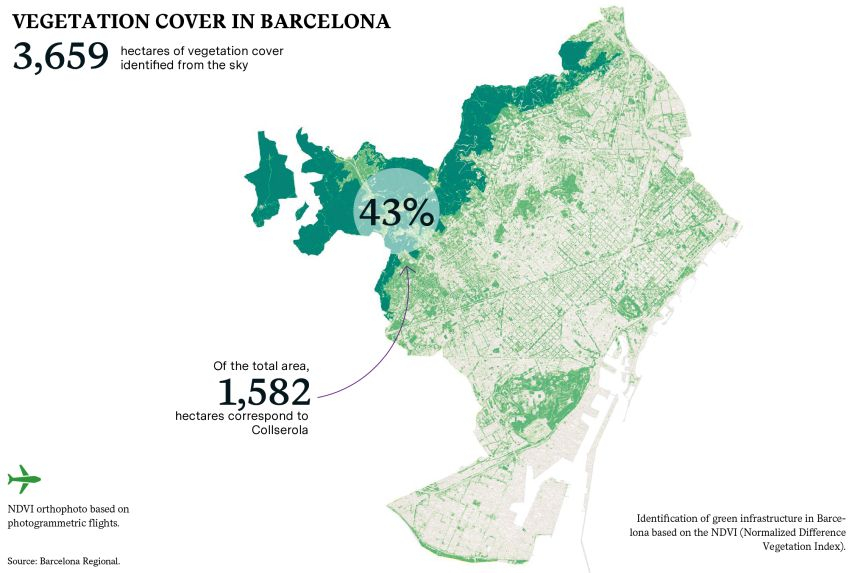Green areas, biodiversity and quality of life
- Open data
- Oct 23
- 4 mins

Oriol Pàmies, texts / Carles Javierre Kohan, infographics
The quantity and quality of vegetation is a key factor for achieving a healthy city and combating climate change. Street trees provide shade and help to regulate the temperature, while trapping pollutant particulates and helping to clean the air and reduce noise. Experience and scientific evidence point to green infrastructure as a public health resource. This is why we need more parks and gardens, especially in the neighbourhoods where they are most lacking, while progress is being made in the ecological management of greenery to make it more diverse and abundant.


Vegetation cover
Sixty-four per cent of Barcelona’s land area is urbanised. The rest is open space covered with vegetation, largely concentrated in the Collserola mountain range. Particularly noteworthy are the holm oak groves, pine forests and dry meadows, home to a rich natural heritage. Parks and gardens, both public and private, constitute the core of the city’s ecological infrastructure, with some particularly important areas: Montjuïc and its escarpments, the Tres Turons Park and Ciutadella, the city’s largest park.

Distribution of greenery
There is a marked contrast in the area of public green space per inhabitant depending on whether Collserola’s forest cover is counted (17 m2) or not (7 m2). The indicator also varies sharply by neighbourhood, to the detriment of those in the central strip, as the map shows. Recent initiatives, such as Green Belts, seek to offset this imbalance, and are in line with the City Council’s stated goal of increasing the green space by 1 m2 per inhabitant by 2030. The World Health Organization recommends that towns and cities should have at least 10-15 m2 of green space per inhabitant.

City of plane trees
Trees are an integral part of the city’s green infrastructure and a hallmark of Barcelona’s identity. Lining streets, squares and parks, they connect the city’s various green spaces and habitats and provides multiple benefits, including improved air quality and lower temperatures, which helps to mitigate the heatwave effect.
The common plane tree has become Barcelona’s emblematic tree (29% of the total), although the first specimens were imported from Girona around 1860. It was chosen by Ildefons Cerdà to adorn the new avenues of the Eixample because of its availability, majesty and rapid growth. Over time, this species has been found to cause discomfort to allergy sufferers, grows long roots and requires frequent pruning.
For these reasons and to foster biodiversity, Barcelona is promoting other species of trees such as the Mediterranean hackberry, the Japanese acacia or sophora, the Chinaberry tree and the tipa. The idea is that no species should exceed 15%.

The example of orchids
The parks are no longer traditionally landscaped, but the greenery is managed to improve its quantity and quality, and so that there is a greater wealth of flora and abundance of fauna. Since 2003, the development of native orchid species has been achieved in historic gardens, which are now a major part of Barcelona’s natural heritage.


Growing resources
The municipal body that manages and promotes the city’s urban greenery and the environment is investing 68 million euros this year in the construction, conservation, remodelling and maintenance of Barcelona’s urban gardens, urban trees, benches and playgrounds.

Forced savings
Amidst the search for the best solutions for sustainable water management, the drought has affected all plans and has imposed a severe restriction on the irrigation of parks and gardens, which is limited to ensuring the survival of plants.


Recreation and social life
As places for recreation, health and socialisation, many parks have areas for children, young people and the elderly, equipped with furniture that is increasingly evolving in terms of quality and safety. For animal welfare, dogs and their owners have more than 100 specific areas at their disposal, half of which are small off-leash enclosures while the remainder are designed as recreational areas.
The newsletter
Subscribe to our newsletter to keep up to date with Barcelona Metròpolis' new developments




